Python is an excellent programming language for both beginners and experienced developers. Its simple syntax, powerful features, and huge community make it the preferred choice for many programmers. Python is a popular language for web development, data analysis, machine learning, and more.
Learning Python is an excellent decision in 2024 as the demand for Python developers is expected to increase. Python is versatile and used in a wide range of applications, from web development to scientific research.
Learning Python will open up new career opportunities and allow you to create applications that were previously beyond your reach.
To learn Python in 2024, you can start with the basics like understanding Python’s syntax, learning about data types, and working with variables and operators. Once you’re comfortable with the fundamentals, you can move on to more advanced concepts like functions, classes, and modules.
To solidify your knowledge, work on real-world projects, and join a Python community to stay updated on the latest trends.
In this article, we’ll walk you through the steps to learn Python in 2024, regardless of your current level.
We’ll discuss the various learning platforms, resources, and tools available to you, ensuring that you have all the information you need to succeed in the world of Python development.
Let’s get started!
What Makes Python Special?
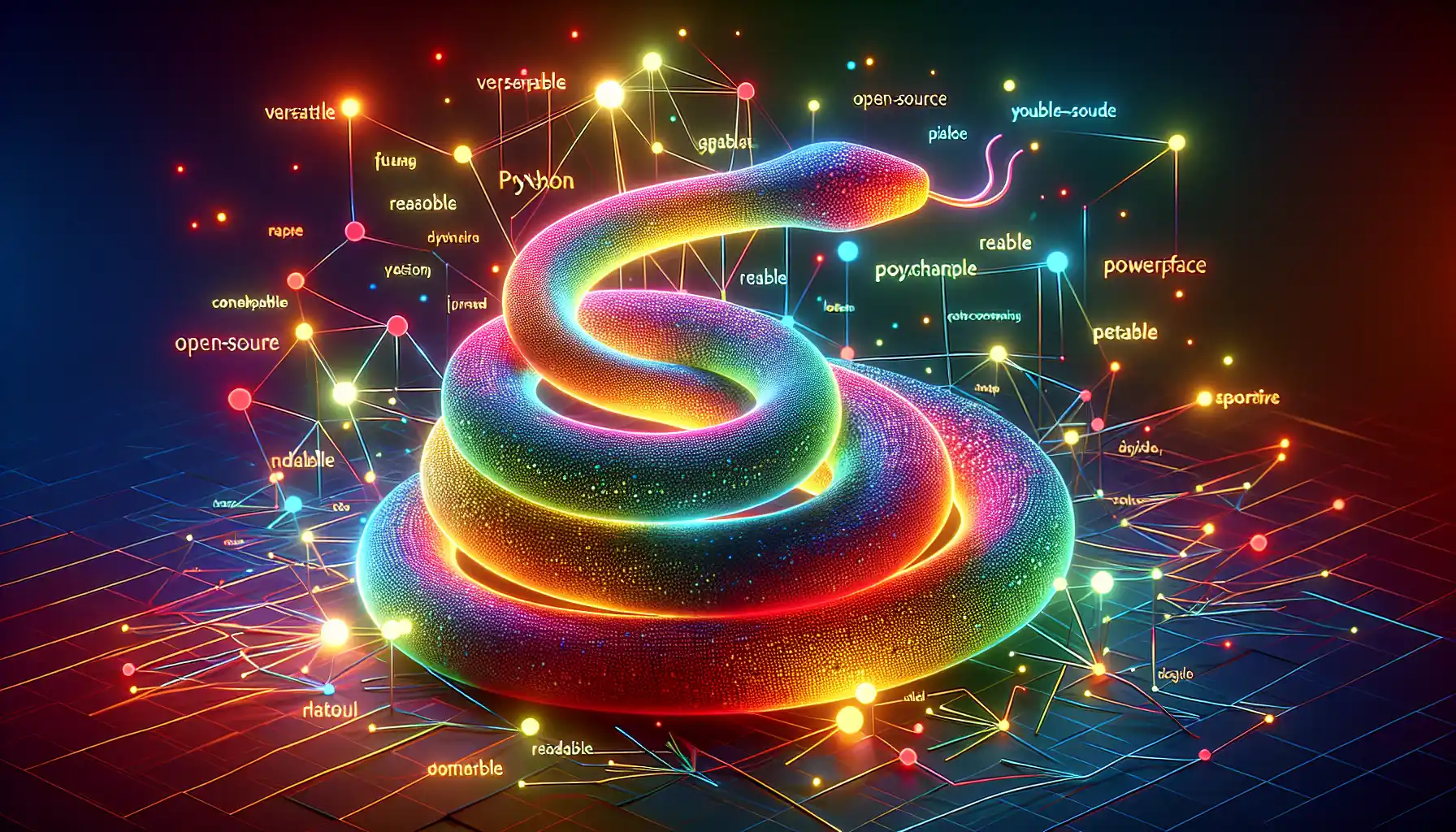
Python is a general-purpose programming language that can be used for web development, data analysis, artificial intelligence, and more. It is known for its simplicity and readability, which makes it an ideal language for beginners.
But what exactly makes Python stand out?
1. User-Friendly: Python is known for its simple and readable syntax. This makes it an excellent choice for beginners who are just starting with programming. It has a minimal learning curve compared to other languages like Java and C++.
2. Versatile: Python is a general-purpose language, meaning it can be used for a wide variety of applications. It is popular in web development, data science, machine learning, artificial intelligence, and more. Python can do everything from simple scripts to complex scientific calculations.
3. Large Community and Ecosystem: Python has a large and active community of developers. This means there are numerous libraries and frameworks available that can help you get your projects done quickly and efficiently. Some popular libraries include NumPy for numerical computations and Pandas for data manipulation.
4. Strong Support for Integration: Python can easily be integrated with other languages like C, C++, and Java. This makes it a great language for working on multi-language projects. It also has support for interacting with different databases, web services, and network protocols.
Now that you have a better understanding of what makes Python special, let’s talk about how you can learn it from scratch.
How to Learn Python From Scratch in 2024

In this section, we’ll walk you through the step-by-step process of learning Python from scratch.
We’ll start with the basics, such as setting up your development environment and learning the syntax of the language, and then gradually move on to more advanced topics.
1. Setting Up Your Development Environment
Before you can start writing Python code, you’ll need to set up your development environment. The two things you’ll need are Python and a code editor or an IDE.
1) Installing Python
The first step is to install Python on your computer. Python is available for all major operating systems like Windows, macOS, and Linux. The official Python website provides installers for each of these platforms.
1. Open your preferred web browser and navigate to the Python website at python.org.
2. Click on the Downloads tab and choose the installer that corresponds to your operating system. If you’re unsure which version to choose, it’s recommended to download the latest stable version.
3. Run the installer and follow the instructions. By default, Python will be installed in the C:\Python folder on Windows and /Library/Frameworks/Python.framework/Versions/3.x on macOS.
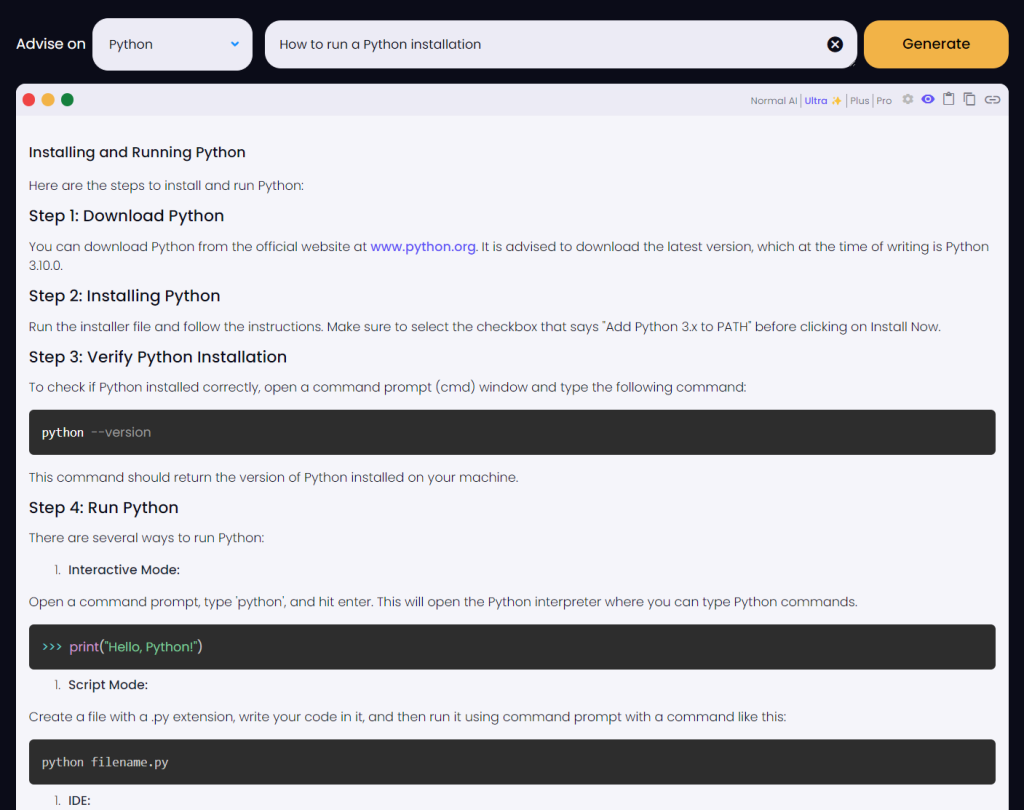
2) Installing a Code Editor
To write Python code, you’ll need a code editor or an integrated development environment (IDE). These are tools that provide features like syntax highlighting, code completion, and debugging.
Some popular code editors for Python are Visual Studio Code, Sublime Text, and Atom. All of these are free and can be downloaded from their respective websites.
2. Learning the Python Syntax and Basics
Once you have your development environment set up, you can start learning the basics of Python. This includes understanding its syntax, data types, and control structures.
Python has a clean and easy-to-understand syntax, which makes it a great language for beginners.
1) Python Basics
1. The first thing you should learn is how to use the Python interpreter. It’s a program that allows you to write and execute Python code. You can start it by simply typing python in your command line.
2. The basic data types in Python are integers, floats, strings, lists, tuples, and dictionaries. It’s important to understand these data types and how to use them in your code.
3. Python has various control structures, including if-else statements, loops, and try-except blocks. These are used to control the flow of your program and make decisions based on certain conditions.
4. Python functions are used to group code that gets executed multiple times. They can be defined using the def keyword and are called using parentheses.
5. One of the key features of Python is its built-in modules and libraries. You can import these using the import statement and use them to extend the functionality of your code.
2) Advanced Python Concepts
As you become more comfortable with the basics of Python, you can start exploring more advanced concepts. Some of these include:
- Object-oriented programming: Python is an object-oriented language. You can create classes and objects to model real-world entities. Inheritance, polymorphism, and encapsulation are some of the key concepts in object-oriented programming.
- Exception handling: In Python, exceptions are runtime errors that can be handled using the try and except statements. This allows you to gracefully handle errors and prevent your program from crashing.
- File handling: Python provides built-in functions for reading from and writing to files. This is an important skill for working with data and persisting information in your applications.
- Regular expressions: Regular expressions are powerful tools for pattern matching and text manipulation. The re module in Python provides support for working with regular expressions.
- List comprehensions and generators: These are advanced techniques for creating and manipulating lists in a concise and efficient way. They are widely used in Python code to write more readable and efficient code.
- Decorators and context managers: These are advanced Python features that are used to modify or extend the behavior of functions and objects. Decorators are commonly used in web frameworks like Flask and Django.
- Threading and multiprocessing: Python has built-in support for concurrent programming using threads and processes. This allows you to perform multiple tasks simultaneously, improving the performance of your applications.
3. Working on Real-World Projects
As you progress in your Python learning journey, working on real-world projects can be an invaluable learning experience. Real-world projects will help you apply your skills and knowledge to solve actual problems. They can also serve as a portfolio to showcase your skills to potential employers or clients.
1) What Type of Projects to Work On?
When choosing a real-world project, it’s important to select something that aligns with your interests and goals. This will keep you motivated and make the learning process more enjoyable.
Some ideas for real-world Python projects include:
- Building a web application using a framework like Django or Flask
- Developing a data analysis tool using libraries like Pandas and NumPy
- Creating a game using a library like Pygame
- Automating repetitive tasks with Python scripts
- Developing a machine learning model using scikit-learn or TensorFlow
- Building a chatbot using natural language processing techniques
2) How to Approach a Real-World Project
When starting a real-world project, it’s important to break it down into smaller, manageable tasks. This will make the project less intimidating and help you stay on track.
Follow these steps to approach a real-world project:
- Define the project scope: Clearly define what the project is supposed to accomplish. What are the goals and objectives?
- Identify the requirements: List down all the features and functionalities the project should have.
- Design the project structure: Plan how the different components of the project will work together.
- Implement the project: Start writing the code to build the project.
- Test the project: Test the project to make sure it works as expected and fix any bugs that may arise.
- Document the project: Write a clear and concise documentation to help other people understand your code.
- Showcase the project: Share your project with others, either by publishing it on a platform like GitHub or by demonstrating it in your portfolio.
- Reflect on the project: After completing the project, take some time to reflect on what went well and what you could improve. This will help you learn and grow from the experience.
4. Joining a Python Community
Joining a Python community is an excellent way to learn Python and keep up with the latest trends and best practices. It also provides you with a platform to seek help, share knowledge, and network with other Python enthusiasts.
1) How to Find a Python Community
There are various online and offline communities dedicated to Python. Here are some places where you can find and join a Python community:
- Online Forums: Websites like Stack Overflow and Python.org have active forums where you can ask questions, share knowledge, and interact with other Python developers.
- Meetup Groups: Many cities have Python meetup groups where you can meet and network with other Python enthusiasts. You can find these groups on websites like Meetup.com.
- LinkedIn and Facebook Groups: There are numerous Python-related groups on social media platforms where you can connect with like-minded individuals.
2) Benefits of Joining a Python Community
Joining a Python community offers several benefits, including:
- Learning from others: In a community, you can learn from the experience and knowledge of others. You can get valuable feedback on your projects and code, which can help you improve your skills.
- Networking: A Python community provides a platform to network with other developers, which can lead to new job opportunities, collaborations, or mentorship.
- Access to resources: Communities often share valuable resources like tutorials, articles, and tools that can help you learn and grow as a Python developer.
- Staying up-to-date: Being part of a community allows you to stay up-to-date with the latest trends, best practices, and news in the Python world.
- Mentorship: Communities often have experienced members who are willing to mentor and guide newcomers in their Python journey.
- Support: A community can provide emotional and technical support when you encounter challenges or roadblocks in your projects.
Joining a Python community is a great way to enhance your learning experience and become a proficient Python developer.
5. Choosing a Python Learning Platform
There are several learning platforms available where you can learn Python. These platforms offer a variety of resources, such as tutorials, courses, and projects, to help you learn Python in a structured and efficient manner.
Here are some of the best Python learning platforms available in 2024:
1) Enterprise DNA
Enterprise DNA is an online learning platform that offers a variety of programming and data related courses, including Python. It’s a great platform for beginners as it provides an interactive learning environment with hands-on projects and exercises.
2) Coursera
Coursera offers Python courses created by universities and educational institutions. You can find both beginner and advanced-level courses, and you have the option to earn a certificate upon completion.
3) edX
edX is another platform that provides Python courses from universities and institutions. It offers both free and paid courses, and you can earn a certificate for completing a course.
4) Udemy
Udemy is an online marketplace for learning, offering a wide range of Python courses. You can find courses on various Python topics, and you can learn at your own pace.
5) DataCamp
DataCamp is focused on data science and offers Python courses that are tailored to data analysis and machine learning. It’s a great platform if you want to learn Python specifically for data science.
6) Real Python
Real Python is a website that offers a collection of tutorials and articles on Python. It covers a wide range of Python topics and is a great resource for both beginners and experienced developers.
All of these platforms provide valuable resources for learning Python. You can choose the one that best fits your learning style and goals.
6. Advanced Python Skills and Development
After you have a solid understanding of the basics of Python, it’s time to dive into more advanced topics. This section will cover the following:
- Learning advanced Python concepts
- Development tools and environments
- Python development frameworks
1) Learning Advanced Python Concepts
Advanced Python concepts include object-oriented programming, decorators, context managers, generators, and asynchronous programming.
You’ll also learn about popular Python libraries like NumPy, pandas, and scikit-learn.
2) Development Tools and Environments
To work on advanced Python projects, you’ll need the right tools and environments. Here are some essential tools for Python development:
- Text Editors: Use text editors like Sublime Text, Atom, or VS Code for writing Python code.
- IDEs: Python-specific integrated development environments like PyCharm and Anaconda are also useful, as they provide features like code completion, debugging, and project management.
- Package Managers: Python comes with a built-in package manager called pip. It allows you to install and manage Python libraries and dependencies.
- Virtual Environments: Virtual environments help you isolate your Python projects. This ensures that different projects can have different library dependencies without conflicts.
- Version Control: Git is a popular version control system that integrates well with Python projects. Use it to track changes in your code and collaborate with others.
3) Python Development Frameworks
Python development frameworks are pre-written code libraries that provide a structure for building applications. Some popular Python frameworks include:
- Django: A high-level web framework for building web applications. It provides features like authentication, database migrations, and an admin panel.
- Flask: A lightweight and flexible web framework that is ideal for small to medium-sized projects. It is easy to get started with and allows for more customization.
- Pyramid: A general-purpose web framework that can be used for building both small and large web applications. It is highly extensible and supports various data storage options.
- FastAPI: A modern web framework for building APIs with Python. It is designed for high performance and comes with features like automatic documentation and data validation.
These frameworks will help you build more complex applications in Python. They handle a lot of the repetitive work, allowing you to focus on implementing the unique features of your project.
7. Python Jobs and Career Outlook in 2024
The demand for Python developers is growing rapidly in 2024. Python is widely used in web development, data science, machine learning, and artificial intelligence. It’s an in-demand skill that can lead to various career opportunities.
Some common Python job titles include:
- Python Developer
- Software Engineer
- Data Scientist
- Machine Learning Engineer
- Full-Stack Developer
- DevOps Engineer
- Python Consultant
- Python Instructor
Python job openings can be found in various industries, including technology, finance, healthcare, and e-commerce.
The average salary for Python developers ranges from $75,000 to $150,000 per year, depending on factors like experience, location, and the specific role.
8. How to Stay Updated With Python Trends
Python is an ever-evolving language, and it’s essential to stay updated with the latest trends and developments. Here are some tips to help you stay updated with Python in 2024:
- Follow Python News Sources: Subscribe to Python newsletters, blogs, and social media accounts to stay informed about the latest Python news, updates, and releases.
- Join Python Communities: Join online and local Python communities, forums, and meetups. Engage in discussions, share knowledge, and learn from others in the community.
- Participate in Python Conferences: Attend Python conferences, workshops, and webinars. These events are a great way to network, learn from experts, and stay updated with the latest Python trends.
- Contribute to Open-Source Projects: Contribute to open-source Python projects. This will not only help you learn and improve your skills but also keep you updated with the latest advancements in the Python ecosystem.
- Take Python Courses: Enroll in Python courses, certifications, and training programs. This will help you learn new techniques, best practices, and stay updated with the latest Python features.
By following these tips, you can stay updated with the latest Python trends and ensure that you’re always using the best and most up-to-date practices in your Python projects.
Final Thoughts
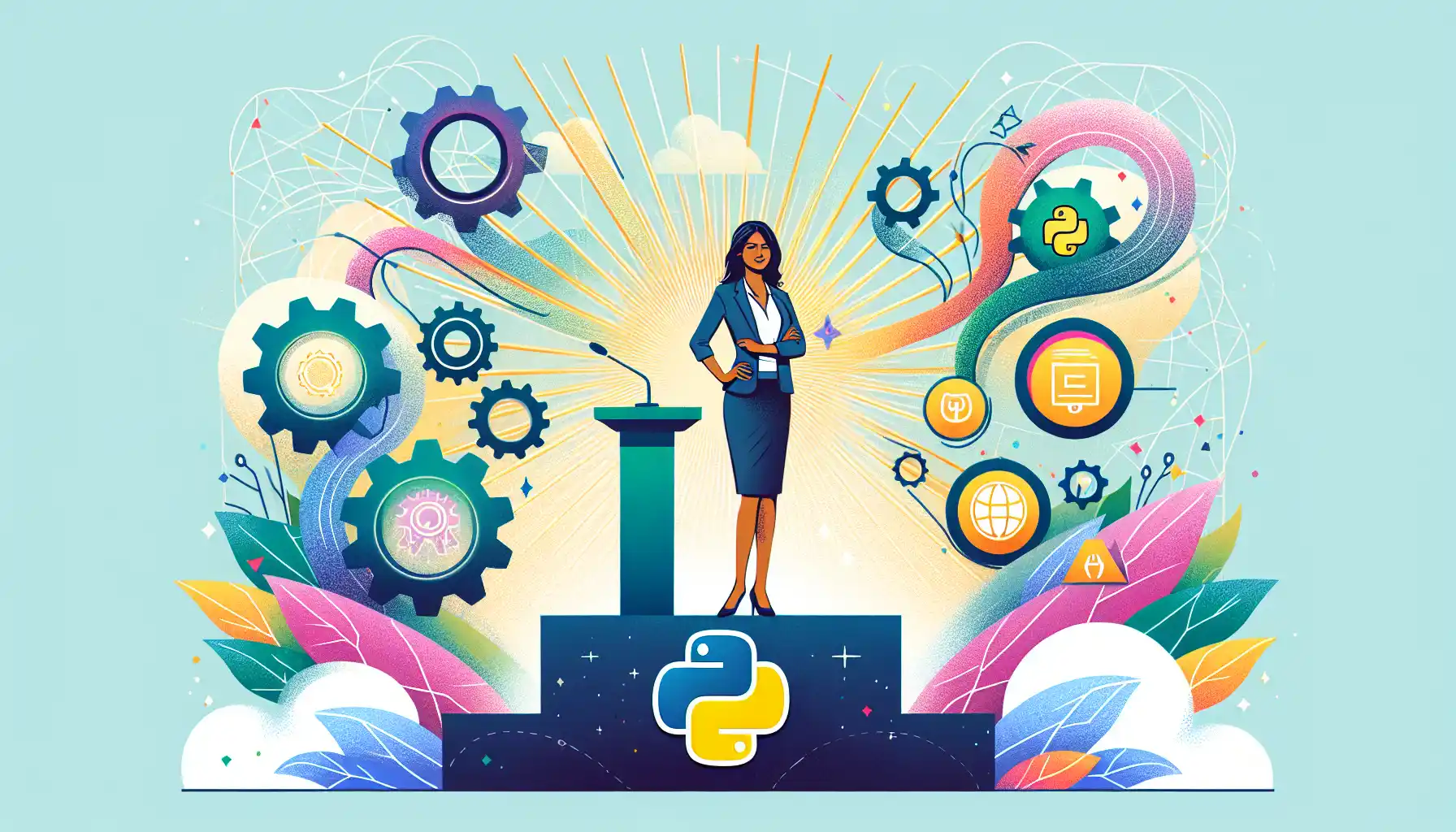
As we look forward to 2024, Python remains a top programming language, with a growing demand for Python developers. Its simplicity, versatility, and extensive community support make it an ideal language to learn.
Python offers a wide range of career opportunities in various industries, and its continuous development ensures that it stays at the forefront of technology.
Embracing Python in 2024 will not only enhance your programming skills but also open up new career paths and exciting possibilities in the ever-evolving world of technology.
Good luck with your Python learning journey, and remember to enjoy the process as you dive into the world of Python development!
Here’s some bonus idea for you!
How to Learn Python: 10 Steps for Success
Learning Python can be a game-changer for your career, personal projects, and overall problem-solving abilities. As a versatile and in-demand programming language, Python is often the go-to choice for developers and data professionals. This is because it simplifies complex tasks, offers a wide range of libraries and frameworks, and is relatively easy to learn.
So, how can you get started with Python and build a strong foundation in the language?
The 10 Steps to Learning Python are:
- Set Your Goals
- Get the Basics Right
- Build a Solid Understanding of Python’s Data Structures
- Start Building Small Projects
- Leverage Free and Paid Resources
- Embrace Python Libraries
- Learn Best Practices and Code Optimization
- Collaborate and Network
- Master Debugging and Problem Solving
- Apply Your Knowledge
In this article, we’ll provide a detailed guide to learning Python. We’ll also offer tips on how to apply your skills to real-world projects, and ultimately, how to stand out as a proficient Python developer. Whether you’re new to programming or looking to add a new language to your skill set, this article will help you build a solid foundation in Python.
Let’s get started!
Step 1: Set Your Goals

The first step to learning Python is to identify why you want to learn it and what you hope to achieve. Python is an extremely versatile programming language, which means that you can use it for a wide range of applications.
For example, you may want to use Python for:
- Web Development: Python is the go-to language for many web developers, thanks to its extensive support through frameworks like Django and Flask.
- Data Science: With libraries such as NumPy, Pandas, and Matplotlib, Python is widely used for data analysis and visualization.
- Machine Learning and AI: Python is the primary language used for building and training machine learning models.
- Game Development: With the help of libraries like Pygame, you can create your own games in Python.
- System Automation: Python is a powerful scripting language that can be used to automate tasks on your computer or server.
By understanding your goals, you can tailor your learning experience to meet your specific needs and become a more proficient Python developer.
Step 2: Get the Basics Right

As with any language, Python has its own set of fundamental concepts and syntax rules that you need to learn in order to start writing code. These basics will provide you with a strong foundation and make it easier for you to understand more complex concepts as you progress.
Some of the fundamental concepts you should focus on include:
- Variables and Data Types: Learn how to create, store, and manipulate different types of data, such as numbers, strings, and lists.
- Control Flow: Understand how to use conditional statements (if-else) and loops to control the flow of your program.
- Functions: Learn how to create and use functions to break down your code into reusable and organized parts.
- Object-Oriented Programming (OOP): Gain a basic understanding of classes and objects, which are essential for building more complex applications.
By mastering these basic concepts, you’ll be able to write clean, efficient, and maintainable Python code.
Step 3: Build a Solid Understanding of Python’s Data Structures

After getting the basics right, it’s essential to learn about Python’s built-in data structures, such as lists, dictionaries, sets, and tuples. Python data structures are powerful tools for organizing, storing, and manipulating data in your programs.
To master data structures, you need to:
- Understand their Purpose: Learn why and when to use each data structure. For example, lists are used when you need an ordered collection of items, while dictionaries are used to store key-value pairs.
- Learn their Syntax and Operations: Become familiar with the syntax for creating and accessing data structures. Also, learn about the various operations that can be performed on them, such as adding or removing elements, sorting, and iterating through the data structure.
- Know their Performance Characteristics: Understand the performance implications of using different data structures in various scenarios. This will help you make informed decisions when designing and optimizing your code.
Step 4: Start Building Small Projects
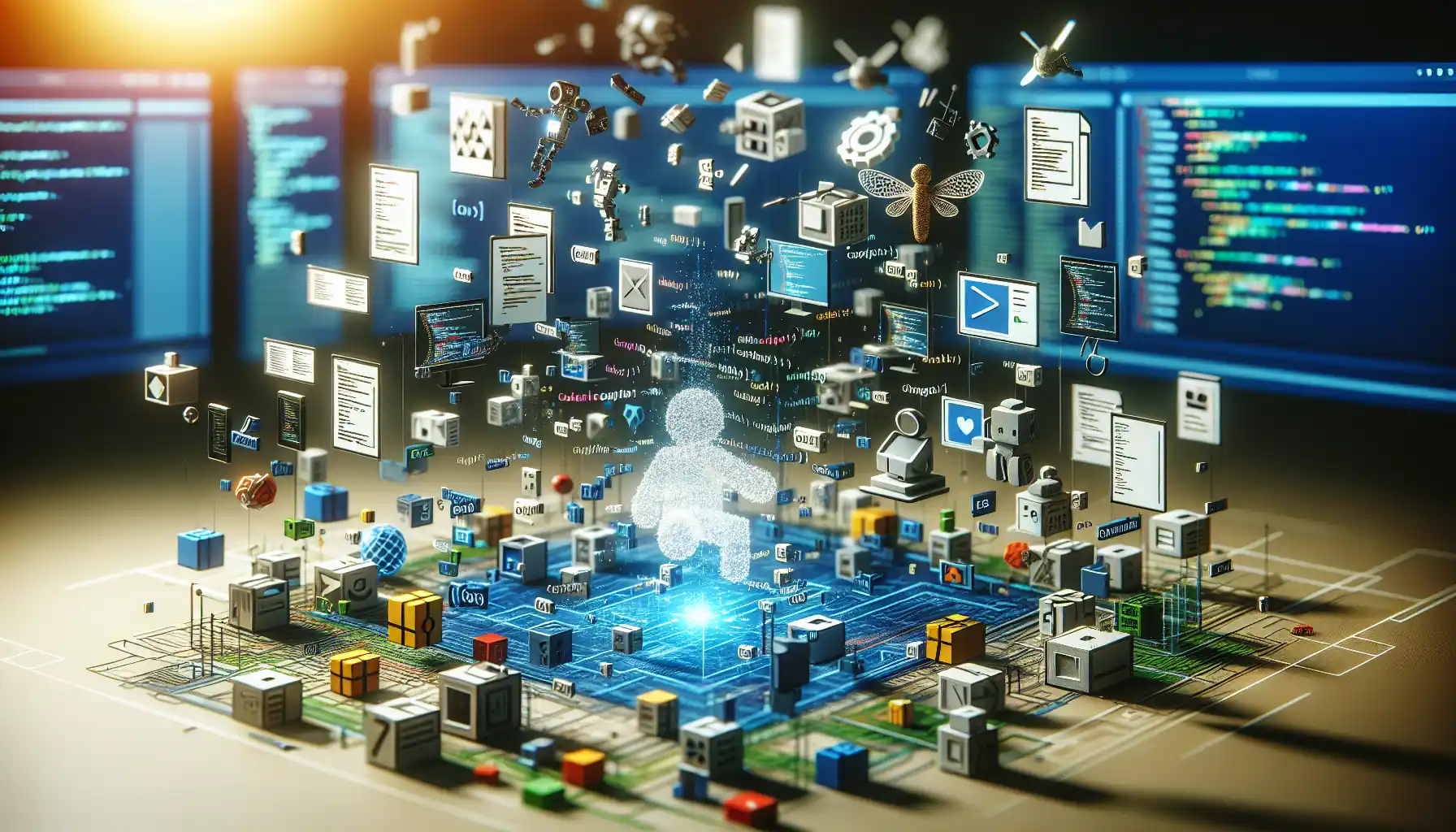
Once you have a good grasp of the basics and data structures, it’s time to put your skills to the test by building small projects. This step is crucial for two main reasons:
- Application of Concepts: Building projects will help you apply what you’ve learned and solidify your understanding of Python. It allows you to see how various concepts and tools work together in a real-world scenario.
- Problem-Solving Skills: It helps you develop problem-solving skills. You’ll encounter challenges and have to figure out how to overcome them. This will make you a better programmer.
Step 5: Leverage Free and Paid Resources

To enhance your Python skills, you need to tap into the vast resources available online. There are numerous tutorials, courses, and forums that can help you learn Python. These resources are designed for both beginners and advanced learners and cover a wide range of topics and use cases.
Here are some resources to consider:
- Interactive Courses and Tutorials: Websites like Codecademy, DataCamp, and edX offer interactive Python courses and tutorials that allow you to learn and practice Python within your web browser.
- Books: There are countless Python books for beginners and experienced developers. You can find books on specific topics, like data science or web development, as well as general Python programming.
- Video Tutorials: Platforms like YouTube and Udemy host video tutorials on Python. These tutorials can be a great way to learn new concepts and see real-world examples of Python code in action.
- Forums and Communities: Websites like Stack Overflow and Reddit have active Python communities where you can ask questions, share your projects, and learn from others.
- Documentation: The official Python documentation is an invaluable resource. It provides detailed information on Python’s syntax, built-in functions, and standard libraries.
- Blogs and Websites: Many blogs and websites, such as Real Python and Python.org, regularly publish articles, tutorials, and code examples that can help you improve your Python skills.
Remember to choose resources that align with your learning goals and preferred learning style. Don’t be afraid to try out different resources until you find the ones that work best for you.
Step 6: Embrace Python Libraries
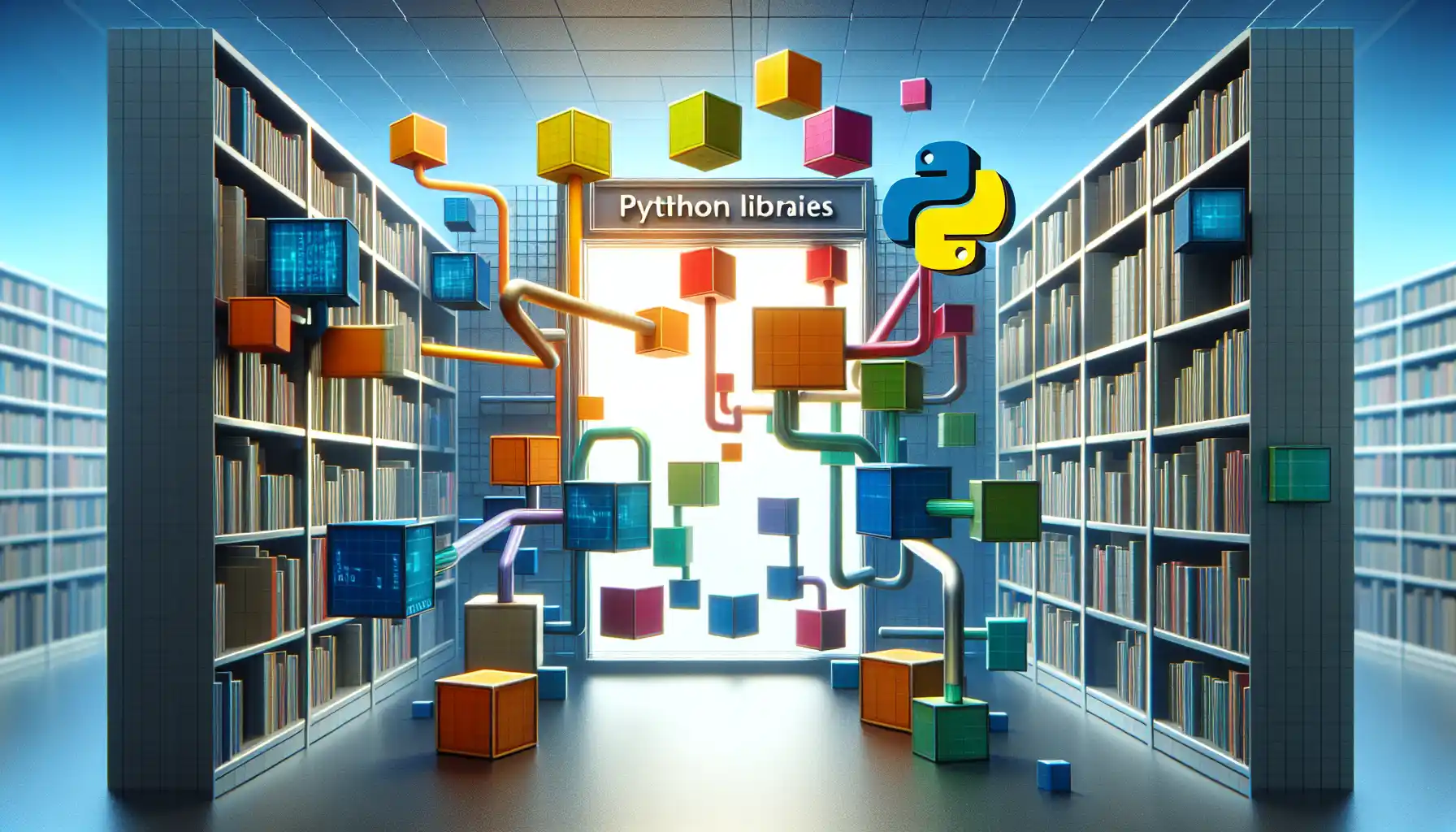
Python is known for its extensive libraries and frameworks, which are pre-written code modules that you can use to perform specific tasks without having to write the code from scratch.
Here are some popular libraries and frameworks you should be familiar with:
- NumPy: A fundamental package for scientific computing with Python. It provides support for arrays, linear algebra, and various mathematical functions.
- Pandas: A powerful library for data manipulation and analysis. It offers data structures and operations for manipulating numerical tables and time series.
- Matplotlib and Seaborn: These are essential data visualization libraries. They allow you to create a wide range of charts, plots, and graphs to visualize your data.
- Django and Flask: These are popular web frameworks for Python. They provide tools and libraries for building web applications, APIs, and websites.
- TensorFlow and PyTorch: These are deep learning frameworks used in machine learning and artificial intelligence. They offer tools for building and training neural networks.
To get the most out of Python, you should explore the various libraries and frameworks available and learn how to use them effectively in your projects.
Step 7: Learn Best Practices and Code Optimization

Python has a well-established set of best practices that you should follow to write clean, efficient, and maintainable code. Adhering to these practices will make your code more readable and less prone to errors.
Here are some best practices to keep in mind:
- PEP 8: Python Enhancement Proposals (PEP) are a set of guidelines and recommendations for writing Python code. PEP 8, in particular, provides a style guide for writing clean, readable code. It covers topics like naming conventions, indentation, and code layout.
- Code Optimization: While Python is known for its readability and ease of use, it’s also important to write efficient code. This includes optimizing algorithms, minimizing the use of global variables, and using built-in functions and libraries whenever possible.
Step 8: Collaborate and Network
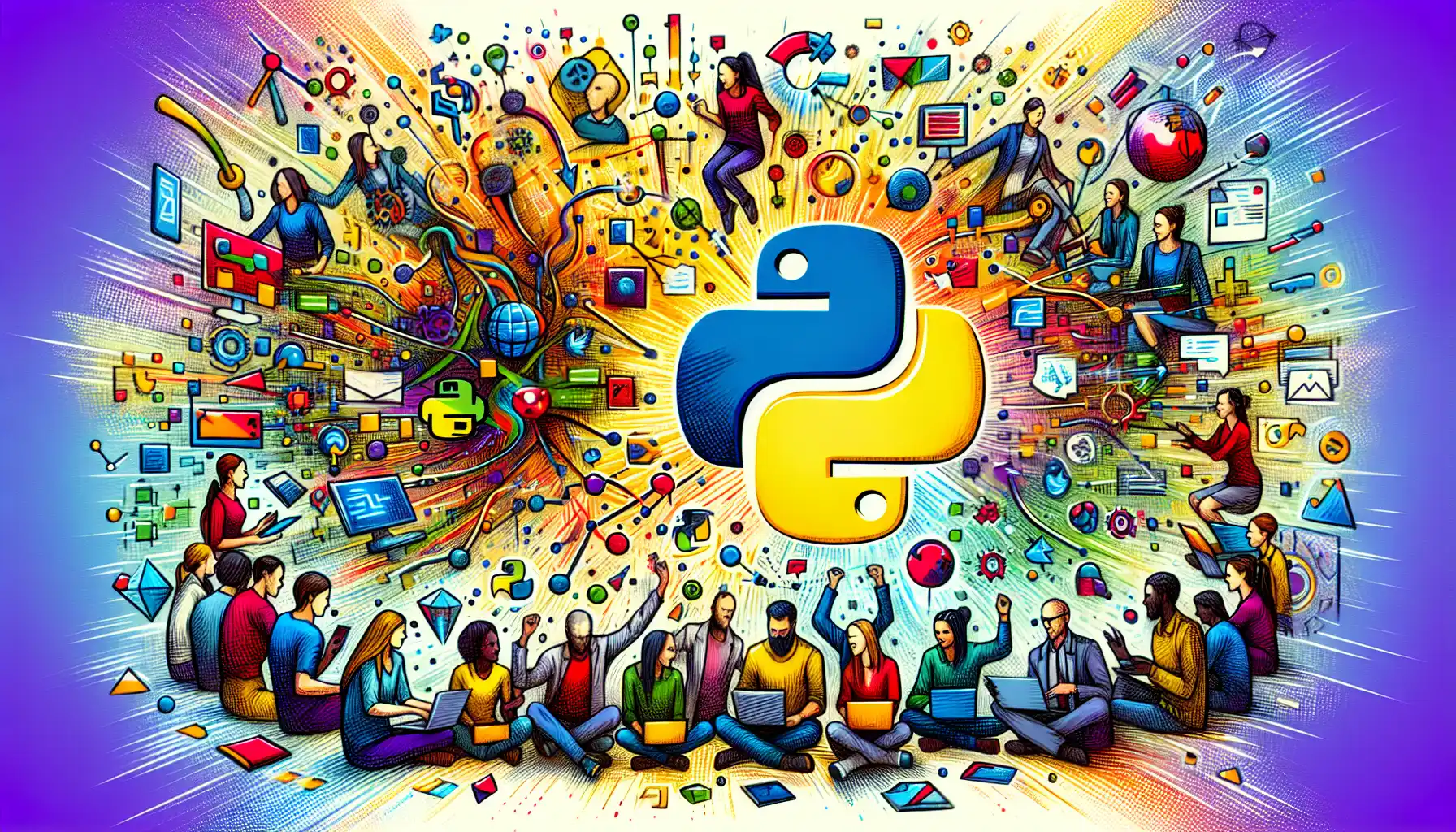
Learning Python is not just about writing code; it’s also about learning from others and sharing your knowledge. One of the best ways to improve your skills is to collaborate with other developers and participate in the Python community.
Here are some ways you can do that:
- Open Source Projects: Contributing to open source projects is a great way to learn from experienced developers and gain practical experience. You can find open source Python projects on platforms like GitHub.
- Meetups and Conferences: Attend local Python meetups, workshops, and conferences to network with other developers, share your experiences, and learn from others.
- Online Communities: Join online Python communities on platforms like Stack Overflow, Reddit, and Discord. These communities are great places to ask questions, share knowledge, and connect with other Python enthusiasts.
- Social Media: Follow Python-related accounts and hashtags on social media platforms like Twitter and LinkedIn. This will keep you updated on the latest trends, news, and resources in the Python community.
- Hackathons and Coding Challenges: Participate in hackathons and coding challenges to test your skills, learn new techniques, and network with other developers.
By collaborating and networking with others in the Python community, you’ll be able to learn new things, get feedback on your work, and stay motivated in your learning journey.
Step 9: Master Debugging and Problem Solving

Debugging is an essential skill for any Python programmer. No matter how experienced you are, you will encounter bugs in your code. Learning how to effectively debug your programs will save you time and frustration in the long run.
Here are some tips for effective debugging:
- Understand the Problem: Before you start debugging, make sure you understand the problem you’re trying to solve and the expected behavior of your code.
- Use Print Statements: One of the simplest ways to debug your code is by using print statements. Insert print statements at key points in your code to see the current state of variables and the flow of your program.
- Leverage Debugging Tools: Python comes with a built-in debugger called pdb. It allows you to set breakpoints, step through your code, and inspect variables. You can also use IDEs like PyCharm or VS Code, which have their own debugging tools.
- Learn to Read Tracebacks: When an error occurs, Python provides a traceback that shows the sequence of function calls leading up to the error. Learning how to read and interpret tracebacks can help you identify the source of the problem.
Step 10: Apply Your Knowledge
After learning the basics of Python, it’s important to apply your knowledge in real-world projects. This will help you:
- Reinforce what you’ve learned
- Gain practical experience
- Develop a portfolio of projects to showcase your skills
When choosing a project, consider your interests and the specific domain you want to work in (e.g., web development, data science, or machine learning). Here are some project ideas to get you started:
- Build a Web Scraper: Use Python to scrape data from websites. This is a great way to learn about HTTP requests, HTML parsing, and data manipulation.
- Create a Personal Blog: Build a simple blog using a web framework like Django or Flask. This will help you understand how to create dynamic web applications.
- Develop a To-Do List App: Create a basic to-do list application with a graphical user interface (GUI) using a library like Tkinter or PyQt.
- Analyze COVID-19 Data: Use Python to analyze COVID-19 data from public datasets. You can create visualizations, calculate statistics, and draw insights from the data.
- Build a Twitter Bot: Create a bot that automatically tweets, retweets, or replies to tweets based on certain criteria.
- Train a Machine Learning Model: Choose a dataset and train a machine learning model using libraries like scikit-learn or TensorFlow.
- Create a Game: Build a simple game using a library like Pygame. This can be a great way to learn about event-driven programming.
- Implement an API: Build a simple RESTful API using a web framework. This will help you understand how APIs work and how to interact with them.
As you work on these projects, don’t be afraid to experiment and try new things. The goal is to learn and grow as a Python developer.
Frequently Asked Questions

What are the steps to learn Python from scratch?
To learn Python from scratch, follow these steps:
- Set up a Python environment on your computer
- Learn the basics of Python syntax and data types
- Practice with small coding exercises
- Learn about control flow and functions
- Explore object-oriented programming and advanced topics
- Build projects and solve problems using Python
- Participate in coding challenges and contribute to open-source projects
What is the best approach to learning Python programming?
The best approach to learning Python is to:
- Start with simple programs and gradually increase complexity
- Focus on writing clean, readable code
- Use online resources and Python courses to learn new concepts
- Join the Python community and participate in discussions
- Practice writing code and solving problems regularly
- Take on projects that interest you and challenge your skills
- Get feedback on your code and learn from your mistakes
How can I become an expert in Python?
Becoming an expert in Python requires a combination of continuous learning, practice, and real-world experience. Start by mastering the fundamentals of Python, including its syntax, data structures, and control flow. As you gain confidence, move on to more advanced topics such as object-oriented programming, functional programming, and Python’s extensive standard library. Additionally, work on real-world projects, contribute to open-source projects, and participate in Python communities to enhance your skills and knowledge.
How long does it take to learn Python?
The time it takes to learn Python can vary depending on your background, experience, and the amount of time you dedicate to learning. Some people may learn the basics of Python in a few weeks, while others may take several months to become proficient. To get a better idea of how long it might take you, set specific learning goals and create a study plan. Additionally, break down your learning into smaller, manageable tasks and practice writing code regularly.
What are the key things to learn in Python?
Some key things to learn in Python include its basic syntax, data types, and data structures, such as lists, dictionaries, and sets. Additionally, learn about control flow and functions, which are essential for writing well-structured and readable code. As you progress, explore more advanced topics such as object-oriented programming, exception handling, and file I/O. Familiarize yourself with Python’s standard library and popular third-party libraries to expand your knowledge and capabilities.








